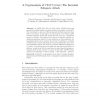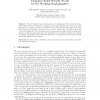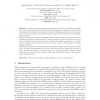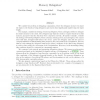181
Voted
CRYPTO
2011
Springer
14 years 18 days ago
2011
Springer
At CHES 2010, the new block cipher PRINTcipher was presented as a light-weight encryption solution for printable circuits [15]. The best attack to date is a differential attack [1...
141
Voted
CRYPTO
2011
Springer
14 years 18 days ago
2011
Springer
Abstract. We present EasyCrypt, an automated tool for elaborating security proofs of cryptographic systems from proof sketches—compact, formal representations of the essence of a...
136
Voted
CRYPTO
2011
Springer
14 years 18 days ago
2011
Springer
Structure-preserving signatures are signatures defined over bilinear groups that rely on generic group operations. In particular, the messages and signatures consist of group elem...
110
Voted
CRYPTO
2011
Springer
14 years 18 days ago
2011
Springer
RFID security is currently one of the major challenges cryptography has to face, often solved by protocols assuming that an on-tag hash function is available. In this article we pr...
131
Voted
CRYPTO
2011
Springer
14 years 18 days ago
2011
Springer
Strong lattice reduction is the key element for most attacks against lattice-based cryptosystems. Between the strongest but impractical HKZ reduction and the weak but fast LLL redu...
111
Voted
CRYPTO
2011
Springer
14 years 18 days ago
2011
Springer
In this paper, we describe versatile and powerful algorithms for searching guess-and-determine and meet-in-the-middle attacks on byte-oriented symmetric primitives. To demonstrate ...
114
Voted
CRYPTO
2011
Springer
14 years 18 days ago
2011
Springer
We present a somewhat homomorphic encryption scheme that is both very simple to describe and analyze, and whose security (quantumly) reduces to the worst-case hardness of problems ...
134
Voted
CRYPTO
2011
Springer
14 years 18 days ago
2011
Springer
In this paper, we initiate a study of zero knowledge proof systems in the presence of sidechannel attacks. Specifically, we consider a setting where a cheating verifier is allow...
137
Voted
CRYPTO
2011
Springer
14 years 18 days ago
2011
Springer
In CRYPTO 1997, Canetti et al.put forward the intruiging notion of deniable encryption, which (informally) allows a sender and/or receiver, having already performed some encrypted...
120
Voted
CRYPTO
2011
Springer
14 years 18 days ago
2011
Springer
We consider the problem of delegating computation, where the delegator doesn’t even know the input to the function being delegated, and runs in time significantly smaller than ...




